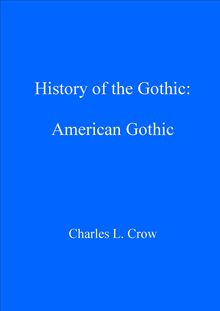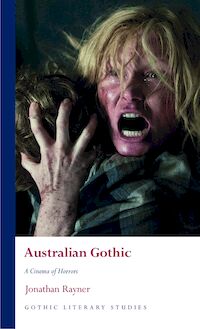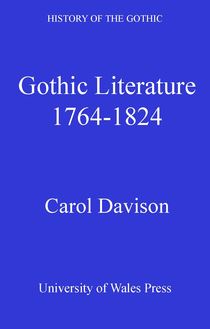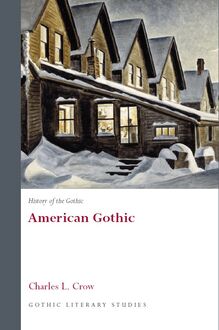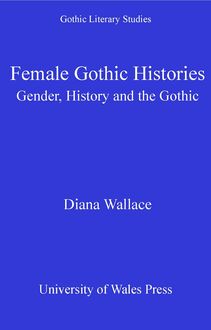Welsh Gothic , livre ebook
131
pages
English
Ebooks
2013
Vous pourrez modifier la taille du texte de cet ouvrage
Obtenez un accès à la bibliothèque pour le consulter en ligne En savoir plus
Découvre YouScribe en t'inscrivant gratuitement
Découvre YouScribe en t'inscrivant gratuitement
131
pages
English
Ebooks
2013
Vous pourrez modifier la taille du texte de cet ouvrage
Obtenez un accès à la bibliothèque pour le consulter en ligne En savoir plus
Publié par
Date de parution
15 mai 2013
Nombre de lectures
3
EAN13
9781783165599
Langue
English
Welsh Gothic, the first study of its kind, introduces readers to the array of Welsh Gothic literature published from 1780 to the present day. Informed by postcolonial and psychoanalytic theory, it argues that many of the fears encoded in Welsh Gothic writing are specific to the history of Welsh people, telling us much about the changing ways in which Welsh people have historically seen themselves and been perceived by others. The first part of the book explores Welsh Gothic writing from its beginnings in the last decades of the eighteenth century to 1997. The second part focuses on figures specific to the Welsh Gothic genre who enter literature from folk lore and local superstition, such as the sin-eater, c n Annwn (hellhounds), dark druids and Welsh witches.
Publié par
Date de parution
15 mai 2013
Nombre de lectures
3
EAN13
9781783165599
Langue
English
WELSH GOTHIC
SERIES PREFACE
Gothic Literary Studies is dedicated to publishing groundbreaking scholarship on Gothic in literature and film. The Gothic, which has been subjected to a variety of critical and theoretical approaches, is a form which plays an important role in our understanding of literary, intellectual and cultural histories. The series seeks to promote challenging and innovative approaches to Gothic which question any aspect of the Gothic tradition or perceived critical orthodoxy. Volumes in the series explore how issues such as gender, religion, nation and sexuality have shaped our view of the Gothic tradition. Both academically rigorous and informed by the latest developments in critical theory, the series provides an important focus for scholarly developments in Gothic studies, literary studies, cultural studies and critical theory. The series will be of interest to students of all levels and to scholars and teachers of the Gothic and literary and cultural histories.
SERIES EDITORS
Andrew Smith, University of Sheffield
Benjamin F. Fisher, University of Mississippi
EDITORIAL BOARD
Kent Ljungquist, Worcester Polytechnic Institute Massachusetts
Richard Fusco, St Joseph s University, Philadelphia
David Punter, University of Bristol
Chris Baldick, University of London
Angela Wright, University of Sheffield
Jerrold E. Hogle, University of Arizona
Welsh Gothic
Jane Aaron
© Jane Aaron, 2013
All rights reserved. No part of this book may be reproduced in any material form (including photocopying or storing it in any medium by electronic means and whether or not transiently or incidentally to some other use of this publication) without the written permission of the copyright owner. Applications for the copyright owner s written permission to reproduce any part of this publication should be addressed to the University of Wales Press, 10 Columbus Walk, Brigantine Place, Cardiff CF10 4UP.
www.uwp.co.uk
British Library CIP Data
A catalogue record for this book is available from the British Library.
ISBN 978-0-7083-2607-7 (hardback) 978-0-7083-2608-4 (paperback)
e-ISBN 978-1-78316-373-1
The right of Jane Aaron to be identified as author of this work has been asserted in accordance with sections 77 and 79 of the Copyright, Designs and Patents Act 1988.
Cover image: I. Havell, The Funeral, 1814, from Cambrian Antiquities
C ONTENTS
Acknowledgements
Prologue: A Long Terror
PART I: HAUNTED BY HISTORY
1 Cambria Gothica (1780s-1820s)
2 An Underworld of One s Own (1830s-1900s)
3 Haunted Communities (1900s-1940s)
4 Land of the Living Dead (1940s-1997)
PART II: THINGS THAT GO BUMP IN THE CELTIC TWILIGHT
5 Witches, Druids and the Hounds of Annwn
6 The Sin-eater
Epilogue: Post-devolution Gothic
Notes
Select Bibliography
A CKNOWLEDGEMENTS
This book owes its origins to those undergraduate students of English at the University of Glamorgan who in the mid-2000s were failing to sign up in sufficient numbers for an optional second-year module on Welsh writing in English. Though the first- and third-year modules on more contemporary Welsh writing were well supported, the second-year option, which dealt with the so-called first flowering of Anglophone Welsh writers, and included on its syllabus such luminaries as Caradoc Evans, Dylan Thomas and the 1930s industrial novelists, failed to appeal, and as a result was threatened with closure. As I sought to find ways of increasing the allure of the material, I noticed that those optional modules offered by the department which featured the Gothic genre were in each year regularly oversubscribed. It proved surprisingly easy to reshape the original module, broaden its chronological scope, and submit it for approval as a new course entitled Terror and the supernatural in Welsh writing in English . Under that title it served to draw sufficient subscribers to satisfy the student numbers requirements of the university for the rest of my time at Glamorgan, but its teaching was somewhat hampered by the fact that there was little secondary critical material available on the topic. This book has been written with the aim of helping to fill that gap; it is dedicated, with gratitude and appreciation, to those students whose lively responses made my years of teaching at Pontypridd so pleasurable.
In preparing the volume for publication I have been much supported by John Koch and Diana Wallace, who both read through the first draft and made many very useful suggestions for amendments; I am much indebted to them both. I should also like to thank those friends and colleagues with whom I discussed various aspects of the book in progress, in particular Helen Phillips, Sarah Prescott, Katriona Mackay, Kirsti Bohata, Huw Walters of the National Library of Wales, and the editor of the Gothic Literary Studies series, Andy Smith. The staff of the University of Wales Press, particularly Sarah Lewis, were also enthusiastically supportive of this project, and I much appreciated their professionalism and diligence.
For kind permission to quote from her poem The Zombie-makers I am very grateful to Ruth Bidgood. Though they have since been revised, parts of the first chapter of this book first appeared in Haunted by history: Welsh Gothic 1780-1800 , in Stewart Mottram and Sarah Prescott, eds, Writing Wales, from the Renaissance to Romanticism (Farnham: Ashgate, 2013), and are used here by permission of the publisher.
To the class of EL2S013
Prologue
A Long Terror
A long terror is on me grieves Gruffudd ab yr Ynad Goch in his thirteenth-century Lament for Llywelyn ap Gruffudd, the Last Prince . Llywelyn s fall in 1282 marked the close of the Welsh struggle to maintain independence in the face of the Anglo-Norman conquerors. The poet represents his prince s death as a trauma of such magnitude that it shatters his world, leaving no place of safety: There is no refuge from imprisoning fear / And nowhere to bide - O such abiding! ( Nid oes le y cyrcher rhag carchar braw; / Nid oes le y triger; och o r trigaw! ). Every aspect of his environment has been defamiliarized; even the diurnal cycle of nature seems in disarray: See you not the sun hurtling through the sky, / And that the stars have fallen? ( Poni welwch-chwi r haul yn hwylaw r awyr? / Poni welwch-chwi r s r wedi r syrthiaw? ). Terror is the only appropriate affective response to such a traumatic loss of security and identity as the death of Llywelyn and the conquest of Wales entailed: When that head fell, men welcomed terror, says the poet ( Pen pan las, ni bu gas gymraw ). 1 Early Welsh poetry is a long litany of such terrors: before the coming of the Normans, bards from the sixth century onwards recorded the invasive onslaughts of the Saxons. The anonymous ninth-century poem Stafell Gynddylan ( Cynddylan s Hall ), for example, laments the sacking of Cynddylan s hall Pengwern, near modern-day Shrewsbury, and the slaughter of the chieftain and his retinue. Written in the voice of one of the few survivors, Cynddylan s sister Heledd, the poem describes Pengwern as dark tonight, / with no fire, no candle , and asks, Save for God, who ll keep me sane? ( Stafell Gynddylan ys tywyll heno, / Heb d n, heb gannwyll; / Namyn Duw pwy a m dyry pwyll? ) 2
It is no coincidence that early Welsh texts like these were re-discovered, published and translated into English for the first time during that epoch which also saw the birth of the Gothic as a literary genre. After the era of Enlightenment with its emphasis on rationality and its valorization of classically influenced literature, writers and scholars of the turbulent second half of the eighteenth century, rebelling against what was perceived as the emotional aridity and repressiveness of the age of reason , actively sought to re-engage with, and create, a literature capable of arousing strong affect, be it sentimental, sublime or terror-ridden. In 1765, Horace Walpole published The Castle of Otranto , hailed as the founding text of the Gothic genre. A year earlier when Evan Evans (Ieuan Prydydd Hir) published Some Specimens of the Poetry of the Ancient Welsh Bards Translated into English (1764) he was participating in a parallel new movement popularized by the immense success of Thomas Gray s The Bard (1757), an ode supposedly sung by the last poet to survive Edward I s alleged extermination of the Welsh bards in 1282 after Llywelyn s fall. Within this Celtic revival movement, early Gaelic and Welsh poetry was seen as illustrative of the unrepressed vitality of pre-Enlightenment culture and as evidence that the Isle of Britain too had once been inhabited by noble savages , free of the artificial constraints of modern civilization. In Gray s ode, the Plantagenet conquerors are roundly cursed: the bards slaughtered by Edward rise again, a grisly band , to weave with bloody hands . . . / The winding sheet of Edward s race ; even the very landscape of Wales, its giant oak and desert cave , swear eternal revenge against the king. 3 From the last decades of the eighteenth century on, the undead voices of the pre-conquest past are frequently to be heard in Welsh and Anglophone writing from Wales, castigating not only Wales s conquerors but also their own descendants, the modern-day Welsh, found wanting in the appropriate spirit of resistance to foreign rule. The long terror of ethnic annihilation persists in such texts, which constitute the core materials of Welsh Gothic as a specific branch of the Gothic genre - or so, at any rate, this book argues.
In recent years Gothic literature referring to the history of imperial conquests and resistance to such conquests has been categorized as participating in the expanding oeuvre of what has been termed postcolonial or imperial Gothic, first labelled as such in Patrick Brantlinger s Rule of Darkness: British Literature and Imperialism 1830- 1914 (1988). 4 To what extent it is appropriate to categorize Welsh culture in gener



